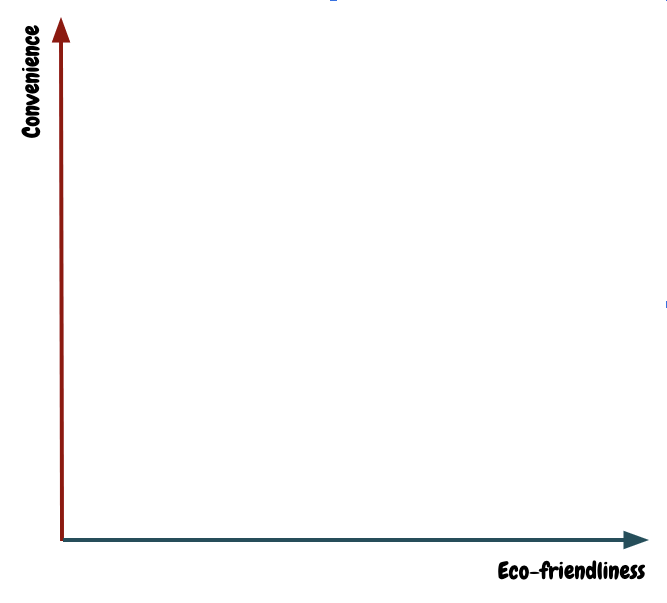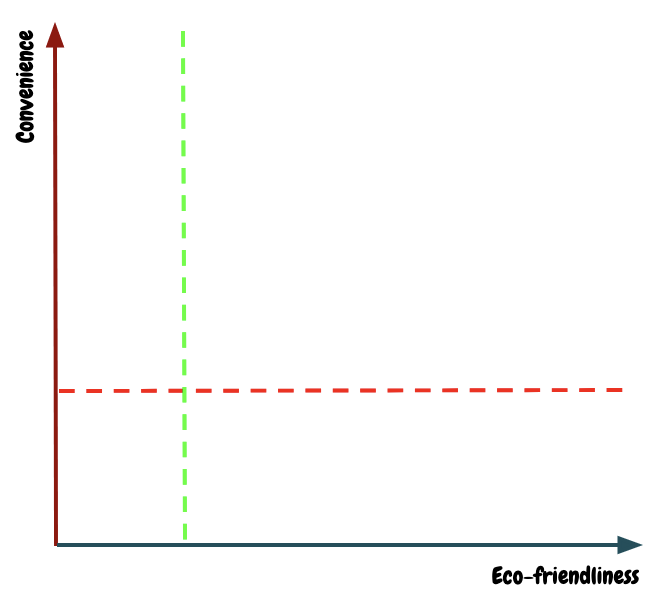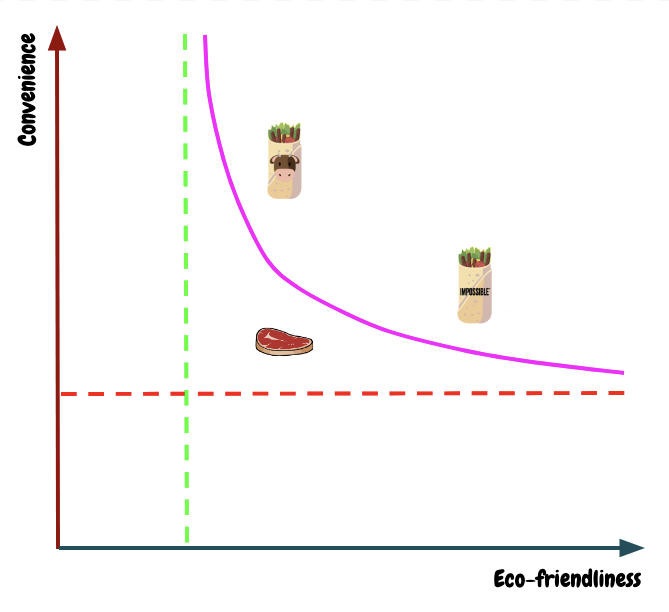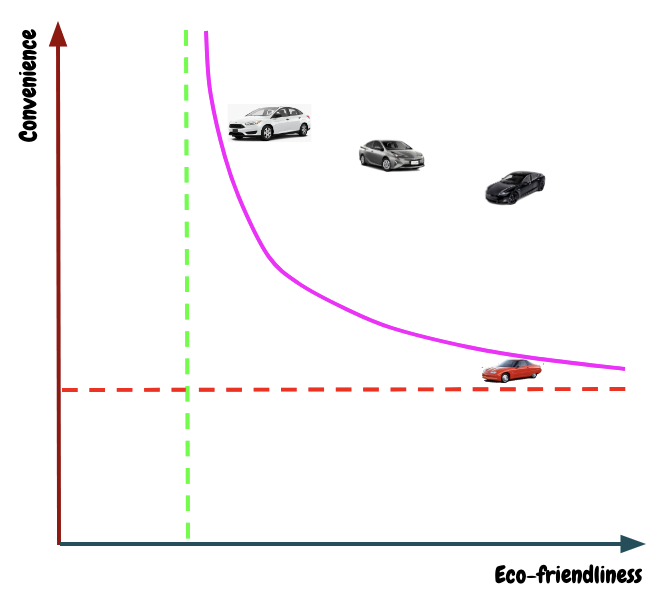I have never been a fan of vegan food no matter how much information I read, heard, absorbed via social media, or from friends on how vegan products is a more efficient method of converting energy from sunlight for humans. I’m aware of global warming and generally concerned about it. I would not use straws and would bring my own bags to the supermarket, however, completely leaving meat out of my meals and stopping myself from enjoying non-vegan food is something that I’m just not ready to give up.
So the folks at Impossible™ made “meat” from plants so that people like me can — in their own words — “Eat meat while saving Earth”. I have heard about them for quite some time but haven’t tried one until I noticed that my favourite take-away kebab joint offers Impossible™ kebabs on their menu.

Kebab impossible to resist?
That moment I knew that I had to have Impossible™ kebab for lunch and beef kebab for dinner with the same complement vegetables and condiments so I could compare them.

Pardon my un-glam bites but they look quite the same eh?
Verdict: Impossible™ meat tastes pretty much the same as beef with a slightly different texture that’s easier to disintegrate (definitely would have it again but not every day 😂). This made me question myself why I’d never tried it until then, and in turns, kickstarted my thought into a rabbit hole of modelling our purchasing decision of green products.
The simple answer to the above mentioned question of why I had never tried Impossible™ and why I decided I would have this again is:
- Availability: I had never seen any of my frequent choices of food offering Impossible™ on their menu until now
- Taste: If it tastes and feels the same as animal-based meat, why not?
- Price: The small difference in price is something I wouldn’t mind compromising on (but an equal or lower price would make me buy more often probably?)
These factors mentioned above contribute and can be consolidated into a dimension of my model, namely, “convenience”. The other dimension of my model, since we’re talking about green products, can’t be anything else but “eco-friendliness”. I’m hypothesising that these are the 2 major dimensions on which people make a purchasing decision of green products.

The bases for our model for economics of green products
As humans, we have certain limits to our decisions and actions. I wouldn’t pay 10 times the usual price of my kebab nor travel 2 hours away from my place to do my part in curbing food with high carbon footprint. Same goes to eco-friendliness, I wouldn’t eat something that tastes like rainbow 🌈 if it immediately raises Earth’s temperature by a degree. Let’s add these limits to our models using these dotted lines.

Left side of the green dotted line and bottom under the red dotted line are non-action zones
However, as we don’t make our decisions based on these limits alone, being in the top right quadrant doesn’t guarantee we would buy these products. So if it’s not the limit lines, what is our boundary for action vs non-action then? How do we combine both aspects of purchasing decisions into a single function? Which mathematical model would take into account both factors without letting either one overpower the other (i.e. not letting something with extremely high convenience value and extremely low eco-friendliness enter the buy zone)? Our answer is product function of convenience and eco-friendliness. Something like

x — eco-friendliness and y — convenience
In the above function, we have x as the variable for eco-friendliness, and y for convenience. lx and ly, respectively, are the limits for these variables (represented by the green dotted line and the red dotted line in our graph previously). C is a constant that represents how hard a buyer we are. The higher C is, the more it takes for us to make a buy decision (And as human we’re, each one of us would have a different C value based on our personal ideologies).
With lx and ly as bounds for eco-friendliness and convenience values (i.e. x > lx and y > ly), we can plot the boundary of the action zone like so — with the boundary (purple line) approaching the limit lines as we go further up or right the graphs but never converging with them (checkout this Wiki if you’d love to find out more).

I reckon this is the kind of curve that mathematicians find sexy
Now let’s apply this model to my meals and see where them kebabs are. Since both of my kebabs are definitely in the buy-zone, for demonstration purpose, I would add in raw beef for cooking — something which would hardly make it to my buy zone as I find cooking too much of a hassle.

Possibilities of my meals
As we can see from the graph, Impossible™ kebab is less “convenient” compared to my normal beef kebab with its higher price but its higher value of eco-friendliness kept it in the buy-zone for me. Raw-beef-for-cooking, despite being in the top-right quadrant — beating both my limits for convenience and eco-friendliness — didn’t make it to the buy zone as its combined value of convenience and eco-friendliness is not enough to get me to action.
The case study of electric cars
Now rewind back to the year 2001, when GM released their electric car model EV1, Stan decided to buy one and was getting all pumped up to amaze his friend Joe about this car and how eco-friendly a person he was.

But..But.. It’s eco-friendly
Stan didn’t even manage to tell Joe that it’s environmentally friendly! And GM EV1 did really prove to be pretty impractical (50mph top speed and 80 miles range full charge) and too expensive to be commercially viable.
Fast-forward to 2012, this time our environmentalist Stan managed to be one of the first people to get himself a newly delivered Tesla model S. Here he is showing Joe his new car.

Joe was truly impressed this time round!
Stan finally had his chance to proudly show off his eco-friendly car with curves as sexy as any other gasoline-powered cars. Going beyond our imaginary story of Stan and Joe, Tesla cars actually compete heads-on with gasoline-powered cars, racking in practical numbers for top speed and range while having eye-catching designs (fun fact: Tesla’s first 4 models’ names combined is “S3XY” if you know what Elon means 😉). On top of that, Tesla managed to build a dense network of supercharger stations, making it a breeze to charge their cars. These are the reasons why Tesla cars sell like hotcakes. So which EV is more likely to save the planet? A model with eco-friendliness as a secondary selling point or one with the major (or sole?) selling point to be environmental friendliness?
Let’s apply our model on these EVs with the additions of a normal gasoline-powered sedan from Ford (white colour) and a hybrid car model from Toyota (grey colour). We should get something like this

Clear winner for Tesla?
From the rough graph that I plot above, doesn’t it look like Tesla is clearly winning the race against less eco-friendly counterparts because it’s not much less “convenient”? However, Tesla EVs (or other commercial EVs on the market) are not yet clearly superior to their gasoline-powered alternatives. Hence, for some people with a higher convenient limit (i.e. due to a smaller budget, or living in a country where there’s no supercharger station, etc), they might still opt for a gasoline-power car — scoring one point for team “Global Warmers”.
Messages to the green economy influencers
Although this is just a fun and random thought experiment of mine (mathematicians and economists please spare my mistakes if there’re any 😅), I hope that it can prompt the influencers of our future green economy to think in multi-dimension.
My hope and encouragement are with product designers and engineers who love to pave the way to a sustainable future to not be discouraged if your green products has not been accepted by consumers. Keep refining, reiterating and pushing the convenience scores of your products up.
My hope is with environmental activists to be more multi-dimensional in your advocacy, instead of advocating to push a single dimension of the equation to a ridiculously off-limit point for a majority of people because that won’t be effective as no one is able to listen to your advice (Just like how sensible people wouldn’t listen to Donald Trump on climate change). Explore alternatives, learn about sustainable solutions if you have to and advocate with the right mission.
My hope is with the mass consumers to adapt to the uncertain future, to adjust your limits, to go beyond our pampering habits of unsustainability, and be more accepting of green products and green lifestyles. The only way out of global warming is a global effort.